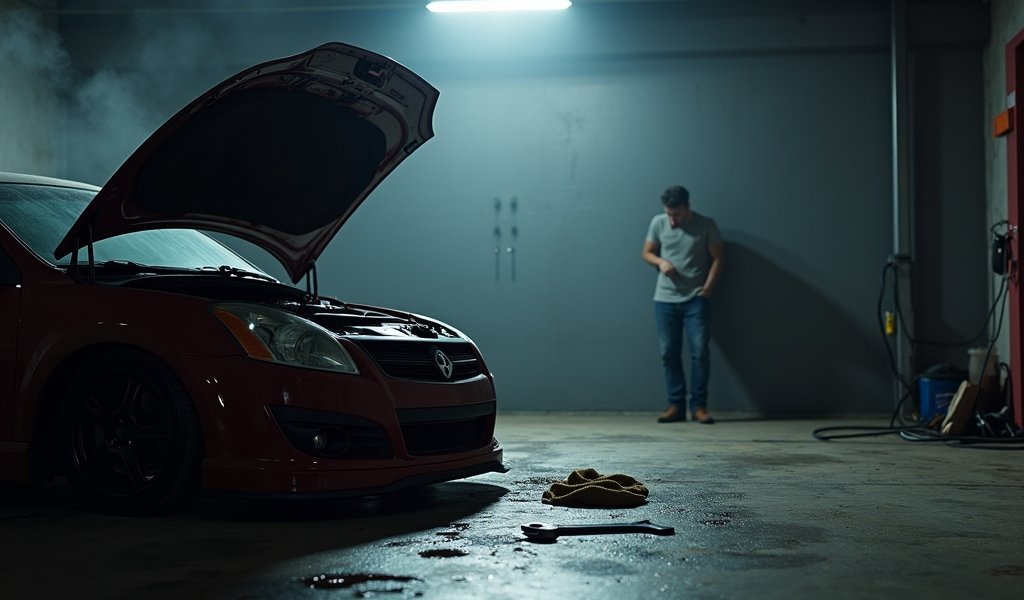Overview
This article explains how shift solenoid problems can cause transmission issues like delayed shifting or getting stuck in gear, with solutions ranging from replacing faulty solenoids to checking fluid levels, fixing electrical connections, performing fluid changes, and updating the transmission control module. The author provides detailed diagnostics, DIY approaches for simple problems, and guidance on when professional help is needed, emphasizing that many transmission issues can be fixed without costly rebuilds.
Table of Contents
- What Are Shift Solenoid Diagnostic Codes?
- 5 Signs Your Shift Solenoid Might Be Going Bad
- Fix #1: Replace the Faulty Shift Solenoid
- Fix #2: Clean the Transmission Fluid and Replace the Filter
- Fix #3: Check and Repair Electrical Connections
- Fix #4: Address Low Transmission Fluid Levels
- Fix #5: Update Your Transmission Control Module
- When to Call in the Pros
- Conclusion
- Frequently Asked Questions
Is your car hesitating before shifting gears? Maybe it’s making weird clunking sounds, or worse—refusing to shift at all? Your transmission’s shift solenoids might be crying out for help. As a mechanic with over 15 years in the field, I’ve seen countless drivers pull into my shop confused and worried about these exact issues. The good news? Many shift solenoid problems can be diagnosed through specific trouble codes and fixed without emptying your wallet.
Think of shift solenoids as the traffic controllers of your transmission. When they start calling in sick, the whole operation falls apart. Let’s dive into what shift solenoid diagnostic codes mean and five proven fixes that might save you from a transmission rebuild nightmare.
What Are Shift Solenoid Diagnostic Codes?
Shift solenoids are small, electronically-controlled valves that direct transmission fluid to the right places at the right time, allowing your automatic transmission to shift gears smoothly. They’re basically the unsung heroes of your transmission’s operation.
When one of these solenoids goes bad, your car’s computer (officially called the Transmission Control Module or TCM) detects the problem and stores a specific trouble code. These codes are like your car’s way of telling you exactly where it hurts.
The most common shift solenoid codes include:
- P0750-P0770: These directly relate to shift solenoid circuit issues
- P0730-P0736: Indicate incorrect gear ratio problems, often solenoid-related
- P0740: Points to torque converter clutch solenoid circuit malfunction
To access these codes, you’ll need an OBD-II scan tool that can read transmission codes. Many basic code readers only catch engine problems, so make sure yours can handle transmission diagnostics. Don’t have one? Most auto parts stores offer free code reading services, or you can visit a local car diagnostic service for a modest fee.
5 Signs Your Shift Solenoid Might Be Going Bad

Before we jump into fixes, let’s talk about how a failing shift solenoid typically behaves. Your car can’t talk, but it sure does communicate when something’s wrong. Here are the telltale symptoms:
- Delayed or harsh shifting: Your transmission pauses before changing gears or slams into gear with enough force to spill your coffee.
- Stuck in one gear: The transmission gets trapped in a single gear (often second) in what we mechanics call “limp mode”—a safety feature designed to get you home without causing more damage.
- Check engine light: That annoying amber glow on your dashboard might be transmission-related, especially if accompanied by other symptoms.
- Transmission slipping: The engine revs but the car barely accelerates, like it’s trying to find the right gear but can’t quite catch it.
- Poor fuel economy: When your transmission isn’t shifting properly, your engine works harder, guzzling more fuel than necessary.
If you’re experiencing two or more of these symptoms, it’s time to get serious about diagnostics and repairs. Let’s look at five fixes that might save your transmission.
Fix #1: Replace the Faulty Shift Solenoid
Sometimes the most direct approach is best. If your diagnostic code points to a specific shift solenoid failure, replacing just that component often solves the problem.
Most cars have 2-5 shift solenoids, depending on the transmission design. They typically cost between $30-$100 per solenoid, with labor adding another $150-$400 if you don’t tackle it yourself. That might sound steep until you compare it to a full transmission rebuild at $2,500-$4,000!
Should you DIY? It depends on your mechanical comfort level and your vehicle. On some cars, solenoids are relatively accessible once you remove the transmission pan. On others, they’re buried inside the valve body, making replacement more complex. According to Motor Magazine’s transmission specialists, always test the electrical resistance of a solenoid before replacing it to confirm it’s actually failed.
Before buying parts, check if your vehicle has any technical service bulletins (TSBs) related to shift solenoids. Sometimes manufacturers identify common failure patterns and release updated parts that last longer. Your local dealer or a subscription to service information can provide TSB details.
Fix #2: Clean the Transmission Fluid and Replace the Filter
Here’s a secret many mechanics know: contaminated transmission fluid causes a surprising number of shift solenoid problems. Dirty fluid can clog the tiny passages in shift solenoids, preventing them from opening and closing properly.
Think of it like cholesterol in your arteries—even if your heart (the solenoid) is healthy, blocked passages prevent proper function. A thorough transmission flush removes nearly all old fluid along with the contaminants that might be causing your solenoid to stick.
Signs your fluid needs changing:
- Dark brown or black color (healthy fluid is bright red or clear red)
- Burnt smell (like overheated cooking oil)
- Visible particles suspended in the fluid
- Fluid appears foamy or has a milky consistency
A proper transmission service should include:
- Complete fluid exchange (not just a drain and fill, which only replaces about 40% of fluid)
- New transmission filter installation
- Pan gasket replacement
- Using the correct fluid type specified for your vehicle (using the wrong fluid can cause as many problems as it solves)
This maintenance should be performed every 30,000-60,000 miles, depending on your driving conditions and manufacturer recommendations. It’s preventative medicine for your transmission that costs around $150-$300—far cheaper than major repairs down the road.
Fix #3: Check and Repair Electrical Connections
Sometimes the solenoid itself isn’t the problem—it’s the electrical system controlling it. Frayed wires, corroded connectors, or loose connections can mimic solenoid failure symptoms.
Start by inspecting the wiring harness connected to your transmission. Look for:
- Physical damage to wires (cuts, melted insulation)
- Corroded terminals
- Loose connections
- Signs of water intrusion in connectors
If you’re comfortable using a multimeter, you can test for continuity in the wiring and proper resistance in the solenoid coil itself. Transmission Digest recommends testing each solenoid circuit from the TCM connector to rule out wiring issues before replacing parts.
Simple electrical problems can often be fixed with:
- Electrical contact cleaner for corroded connections
- Dielectric grease to prevent future corrosion
- Heat-shrink tubing or quality electrical tape for damaged insulation
- New connectors for severely damaged terminals
After making repairs, disconnect your car’s battery for about 30 minutes. This allows the transmission control module to reset, potentially clearing stored error codes and adapting to your repairs.
Fix #4: Address Low Transmission Fluid Levels

Like trying to shower with a trickle of water, solenoids can’t function properly without adequate fluid. Low transmission fluid levels can trigger solenoid-related codes even when the components themselves are perfectly fine.
Checking your transmission fluid level varies by vehicle:
- Traditional dipstick: Ensure the car is on level ground, warmed up, and with the engine running. Shift through all gears before checking.
- Sealed transmissions: Many newer vehicles have no dipstick. These require special procedures involving temperature monitoring and often need to be checked by professionals.
If your fluid is low, you likely have a leak that needs addressing. Common leak points include:
- Pan gasket
- Output shaft seal
- Input shaft seal
- Cooler lines
- Transmission case cracks
Finding transmission leaks can be tricky. I often recommend adding UV dye to the system and using a blacklight to locate the exact source. This approach is much more precise than guessing based on where fluid appears to be collecting.
While there are stop-leak additives available, I consider these temporary band-aids at best. For a lasting repair, identify and fix the specific leak point. A proper seal or gasket replacement typically costs $150-$400 depending on location and accessibility.
Fix #5: Update Your Transmission Control Module
Just like your phone needs software updates, modern transmissions sometimes need their control modules updated. Manufacturers periodically release software improvements to address known issues with transmission operation.
You should consider a TCM update when:
- You have recurring solenoid codes despite replacing components
- Your vehicle has a known technical service bulletin related to shifting issues
- Your transmission exhibits intermittent problems that come and go unpredictably
Updating your TCM isn’t typically a DIY job unless you have specialized equipment. Dealership service departments can perform these updates using manufacturer-specific programming tools. Some advanced independent shops with the right equipment can also handle these updates.
The cost typically ranges from $75-$300 depending on the complexity and vehicle type. While not cheap, a software update can often resolve persistent shifting issues for less than the cost of replacing parts unnecessarily.
After updating, you might notice:
- More consistent shifting patterns
- Fewer false diagnostic codes
- Better overall transmission performance
- Slightly improved fuel economy
When to Call in the Pros
While the fixes above can solve many shift solenoid issues, some situations call for professional expertise from a qualified transmission repair service. Here’s when to pick up the phone:
- You find metal shavings in the transmission fluid (indicates internal damage)
- Grinding or whining noises accompany shifting problems
- The transmission completely fails to engage any gear
- You have multiple diagnostic codes pointing to different transmission components
- You’ve replaced solenoids but the problem quickly returns
Professional diagnosis typically costs $75-$150, but it’s money well spent if it prevents you from replacing parts unnecessarily. A transmission specialist has the equipment to perform pressure tests, scan for manufacturer-specific codes, and analyze the transmission’s behavior in ways DIY tools simply can’t match.
When choosing a transmission shop, look for:
- ASE-certified technicians (specifically with A2 and A3 certifications)
- Shops that specialize in transmissions rather than general repair facilities
- Warranties on both parts and labor
- Positive reviews specifically mentioning transmission work
Don’t be afraid to ask questions about their diagnostic process. A good shop will take the time to explain what they found and why they recommend specific repairs.
Conclusion
Shift solenoid issues can feel overwhelming, but armed with the right diagnostic codes and understanding of these five fixes, you’re already ahead of the curve. Many transmission problems that trigger solenoid codes can be solved without major surgery on your transmission—or your wallet.
Remember that preventative maintenance is your best defense. Regular fluid changes, prompt attention to warning lights, and avoiding aggressive driving habits can extend the life of your transmission components, including those crucial shift solenoids.
Whether you’re a DIY enthusiast ready to tackle solenoid replacement or just want to understand what’s happening before heading to the shop, knowing about shift solenoid diagnostic codes puts you in the driver’s seat of your vehicle’s health.
And if you’re not sure where to start, don’t worry—that’s what the professionals are for. Sometimes the smartest fix is knowing when to ask for help.
Frequently Asked Questions
How much does it cost to replace a shift solenoid?
Parts typically cost $30-$100 per solenoid, with labor adding another $150-$400 depending on accessibility and vehicle model. Total cost usually ranges from $200-$500 for a single solenoid replacement.
Can I drive with a bad shift solenoid?
You can drive short distances with a faulty solenoid, especially if the transmission enters “limp mode.” However, continued driving risks causing more extensive and expensive transmission damage.
Will a transmission flush fix shift solenoid problems?
A transmission flush can fix solenoid issues if they’re caused by dirty fluid or debris clogging the solenoid passages. It won’t repair physically damaged or electrically failed solenoids.
How long do shift solenoids typically last?
Most shift solenoids last 80,000 to 150,000 miles under normal conditions. Regular transmission fluid changes significantly extend their lifespan.
Can I replace just one shift solenoid or should I replace them all?
You can replace just the faulty solenoid if diagnostic codes point to a specific unit. However, if your vehicle has high mileage and one has failed, others may not be far behind.

